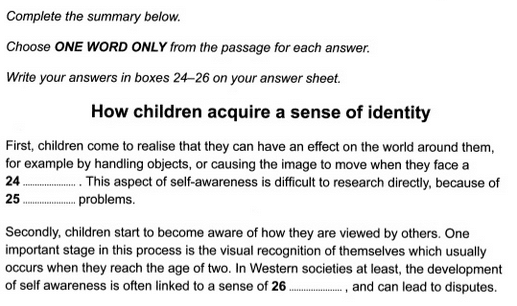In summary completion question types, you will be given a summary of information from the text and there will be some gaps in that summary.
You will either be given a list of words to fill the gaps with or asked to find the answers in the reading text.
Your job is to insert some of the words from the list into the gaps, or if asked, to fill the gaps with words from the text.
There will be more words in the list than required to fill the gaps.
All of the information contained in the summary will also be contained in the reading text, but they will use synonyms and paraphrasing, so don’t expect to see the same words.
Summary completion questions test your ability:
- to understand the general meaning of the summary
- to scan for the correct information in the text
- to be able to identify synonyms and paraphrases
This post will:
- look at example questions
- discuss common problems
- give you tips and advice
- provide you with a strategy to use on exam day
Summary Completion Examples
Below is an example of a question that asks you to fill in the gaps with words from the reading text.
Source: Cambridge English IELTS Past Papers.
Below is another example, but this question is asking you to choose the correct answer from a list of options. You should notice that there are more options than answers.
Source: Cambridge English IELTS Past Papers.
Summary Completion Common Problems
This question does not expect you to have a detailed understanding of the text. Some students lose lots of time reading the whole text and trying to understand everything. You don’t need to do this, focus more on the summary in the question.
Some students read the summary and then look for the exact same words in the reading text. You are unlikely to find these because the examiners use synonyms and paraphrasing.
A common mistake is to ignore grammar rules when completing the summary. If the sentence does not make sense grammatically, then you have the wrong answer.
The examiners also try to trick you by putting a word from the text as one of the options. Some students recognise this and think this is the correct answer. It is probably wrong because the answer will normally be a synonym rather than a matching word.
Summary Completion Tips
- Try to predict the answers before you look at the options or the text. This will help you spot the correct answer.
- Should the gap be filled with a verb, noun, adjective or adverb? If your answer makes the sentence grammatically wrong, then you have the wrong answer.
- Look for synonyms and paraphrases in the text rather than words that directly match.
- Don’t spend too much time looking for the answer to one question. If you can’t find it, mark what you think it might be and move on. Focusing on the easier answers is a better use of your time.
- The answers normally come in the same order as the questions.
- If you get a list of words, think about the ones that can’t be the correct answer because of meaning or grammar. You can then eliminate these words.
Summary Completion Strategy
This is my suggested strategy. There are many different strategies and you should use the one you feel comfortable with. You can also adapt this strategy to what suits you.
- Read the question carefully. Note how many words you can write (normally one, two or three) and if you should get the words from the reading text or a list.
- Skim the summary and try to understand the overall meaning.
- Try to predict the answers before you look at the reading text. Also, think about the word type (noun, verb, adjective) that should be included.
- If you have a list of words, try to guess which 2 or 3 the answer might be. Pay attention to words that collocate well with the words in the sentence.
- Identify which part of the reading text the summary relates to. Scanning for synonyms from the summary will help you do this.
- Look at that part of the section more carefully and choose the correct answer. Remember to be careful with synonyms.
- Check to see if your word makes the sentence grammatically correct.


